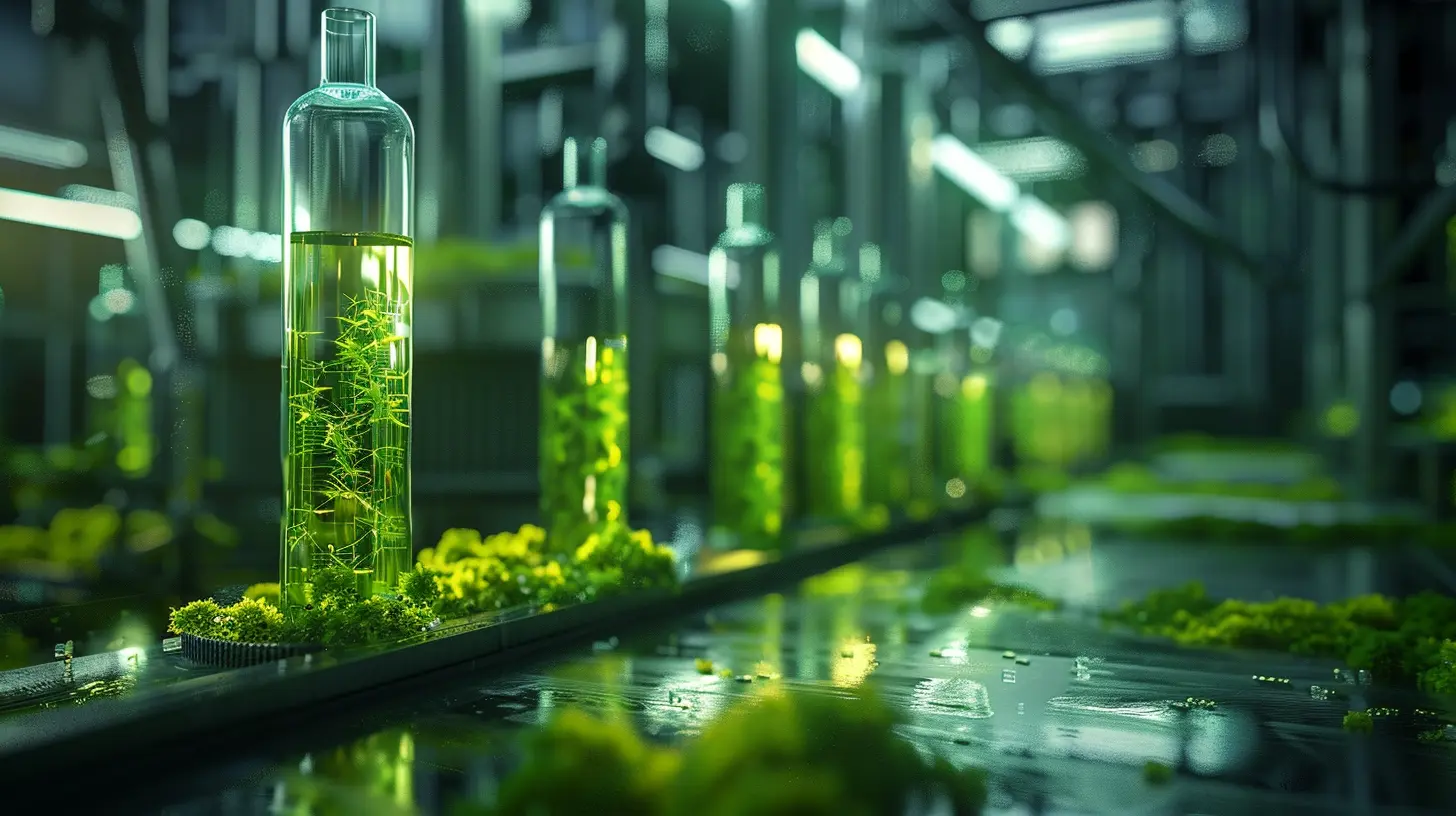The Next Big Thing in Green Tech: Algae-Based Biofuels
21 September 2025
Green tech is all about finding sustainable solutions to the world’s energy needs, and we've seen some pretty impressive innovations over the years. Solar power, wind energy, electric cars—all of them have made significant strides. But, what if I told you that the next big thing in green tech might not come from the sun, wind, or even the ground? Instead, it could come from the water. More specifically, from algae. That's right, algae-based biofuels are gaining a lot of attention as a potential game-changer in the renewable energy sector.
In this article, we’re diving deep into the world of algae-based biofuels, exploring how they work, why they matter, and what makes them stand out as a promising alternative to traditional fossil fuels.

What Are Algae-Based Biofuels?
So, what exactly are algae-based biofuels, and how are they different from the biofuels we already know?Biofuels, as the name suggests, are fuels derived from biological sources. Most of the biofuels we use today come from crops like corn, sugarcane, or soybeans. But algae-based biofuels, also known as algal biofuels, are derived from—you guessed it—algae.
Algae are simple aquatic organisms found in both freshwater and marine environments. They’ve been on Earth for billions of years and can grow rapidly in the right conditions. But here's where it gets interesting: some algae species are incredibly rich in oils, which can be harvested and converted into biofuels like biodiesel, bioethanol, or even jet fuel.
How Do Algae-Based Biofuels Work?
The process of turning algae into fuel may sound complex, but it’s pretty straightforward once you break it down. Here’s how it works:1. Algae Cultivation: First, algae are grown in either open ponds or closed systems called photobioreactors. These systems provide the right conditions for algae to thrive—plenty of sunlight, water, and nutrients like carbon dioxide.
2. Harvesting: Once the algae have grown sufficiently, they are harvested. This involves separating the algae from the water, usually through filtration or centrifugation.
3. Extraction of Oils: Algae are then processed to extract the oils (lipids) they produce. These oils are the key ingredient for creating biofuels.
4. Conversion to Fuel: The extracted oils undergo chemical processes like transesterification (for biodiesel) or fermentation (for bioethanol) to turn them into usable fuels.
Voila! You’ve got algae-based biofuel ready to use. But why algae? What makes them so special?

Why Algae-Based Biofuels Are a Big Deal
If you’re wondering why we’re getting so excited about algae, there are quite a few reasons. Let’s break down the major benefits that make algae-based biofuels a potentially revolutionary energy source.1. High Yield Potential
One of the biggest advantages of algae is their ability to produce a lot of biomass in a short amount of time. Algae can grow at an astonishing rate—some species can double their mass in just a few hours. That means you can harvest far more biofuel from algae than from traditional crops like corn or soybeans.To put it in perspective, algae can produce up to 300 times more oil per acre than traditional biofuel crops. That’s a huge difference when you’re talking about scaling up production to meet global energy demands.
2. Minimal Land Use
Unlike traditional biofuel crops, algae don’t require vast amounts of arable land. They can be grown in water, which means they don’t compete with food crops for land. This is a big deal because one of the criticisms of biofuels is that they can drive up food prices by taking up valuable farmland.Algae can be grown in ponds, tanks, or photobioreactors, and they can even thrive in areas that are unsuitable for agriculture, such as deserts or coastal regions. This flexibility makes algae a much more sustainable option than land-hungry crops.
3. Carbon Capture Capabilities
Here’s where algae really shine. As part of their natural growth process, algae absorb carbon dioxide (CO2), one of the major greenhouse gases responsible for climate change. In fact, algae need CO2 to survive, and they can absorb it efficiently during photosynthesis.This means that algae-based biofuels have the potential to be carbon-neutral or even carbon-negative. Imagine a fuel that not only provides energy but also helps reduce the amount of CO2 in the atmosphere. That’s a game-changer in the fight against climate change.
4. No Competition with Food Crops
We’ve already touched on this, but it’s worth highlighting again. One of the major drawbacks of conventional biofuels is that they often rely on crops that could otherwise be used to feed people. Corn-based ethanol, for example, has been criticized for driving up food prices and contributing to food shortages.Algae, on the other hand, don’t compete with food crops because they can be grown in non-arable areas. This makes them a much more ethical and sustainable source of biofuel.
5. Efficient Water Use
Another environmental benefit of algae is their relatively low water requirements. Algae can be grown in saltwater or wastewater, meaning they don’t rely on freshwater resources that are already in short supply in many parts of the world.This is a big win for sustainability, especially when you consider that other biofuel crops like corn and sugarcane require large amounts of freshwater for irrigation.

The Challenges of Algae-Based Biofuels
Of course, as with any emerging technology, algae-based biofuels aren’t without their challenges. While they hold tremendous promise, there are still a few hurdles to overcome before they can become a mainstream energy source.1. Cost of Production
One of the biggest challenges facing algae biofuels is the cost. Right now, it’s still more expensive to produce algae-based biofuels than traditional fossil fuels or even other biofuels. This is largely due to the infrastructure needed to grow, harvest, and process algae at scale.However, as with any new technology, costs are expected to come down as production methods become more efficient and economies of scale kick in. In fact, researchers are already working on ways to make algae biofuels more cost-effective, such as using genetic engineering to create algae strains with higher oil content or developing more efficient harvesting techniques.
2. Energy Input
Another challenge is the amount of energy required to grow and process algae. While algae are incredibly efficient at converting sunlight and CO2 into biomass, the systems used to cultivate and harvest them (like photobioreactors) can be energy-intensive.Again, this is an area where innovation is likely to play a key role. Researchers are working on ways to reduce the energy input required for algae cultivation, which could make the process more sustainable and economically viable in the long run.
3. Scaling Up
While algae-based biofuels have been successfully produced on a small scale, scaling up production to meet global energy demands is another challenge. Growing enough algae to replace even a fraction of the world’s fossil fuel consumption would require massive infrastructure and investment.That being said, many companies and governments are already investing in algae biofuel research and development, and it’s likely that we’ll see significant progress in the coming years.

The Future of Algae-Based Biofuels
So, what does the future hold for algae-based biofuels? While there are certainly challenges to overcome, the potential benefits are too great to ignore. As the world continues to seek out sustainable alternatives to fossil fuels, algae-based biofuels are likely to play a key role in the transition to a greener, more sustainable energy future.In fact, several companies are already making strides in this area. For example, ExxonMobil has been investing heavily in algae biofuel research, and they’ve partnered with Synthetic Genomics to develop algae strains that can produce more oil. Similarly, companies like Algenol and Solazyme are working on commercializing algae-based biofuels for use in transportation and aviation.
With the right investment and technological advancements, we could see algae-based biofuels become a major player in the global energy market within the next decade or two. And who knows? The fuel that powers your car or plane in the future might just come from a humble pond of algae.
Conclusion
Algae-based biofuels are an exciting and promising development in the world of green tech. With their high yield potential, minimal land use, carbon capture capabilities, and ability to grow in non-arable areas, algae offer a sustainable alternative to traditional fossil fuels and even other types of biofuels.While there are still challenges to overcome, the future looks bright for algae-based biofuels. As research continues and costs come down, we may soon see algae playing a major role in powering the world’s energy needs—without the environmental impact of fossil fuels.
So, the next time you look at a slimy pond of algae, just remember: it might hold the key to a greener, more sustainable future.
all images in this post were generated using AI tools
Category:
Green TechnologyAuthor:

Michael Robinson
Discussion
rate this article
1 comments
Marigold McManus
Algae-based biofuels present a promising frontier in green technology, marrying innovation with sustainability. As we harness this abundant resource, we potentially unlock a vital solution to energy needs while reducing carbon footprints. Embracing such initiatives could be pivotal in our pursuit of a cleaner, more sustainable future.
September 21, 2025 at 11:49 AM

Michael Robinson
Thank you for your insightful comment! I completely agree that algae-based biofuels offer a unique opportunity to advance sustainable energy solutions while addressing environmental challenges.


